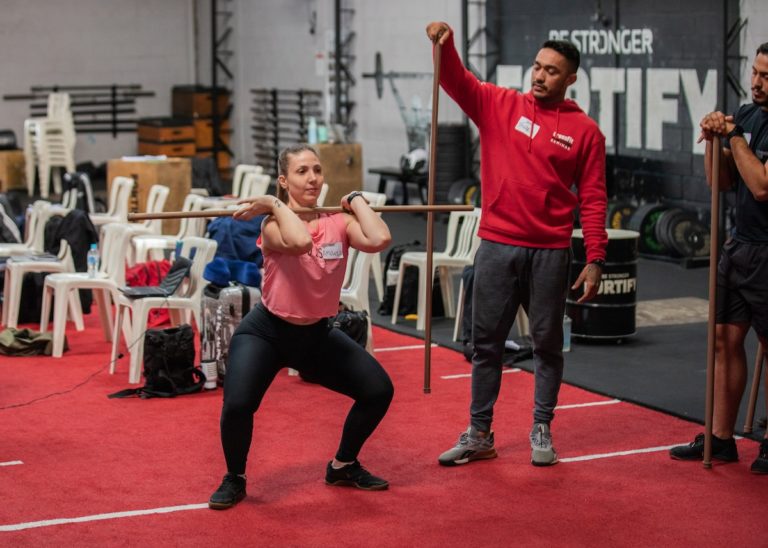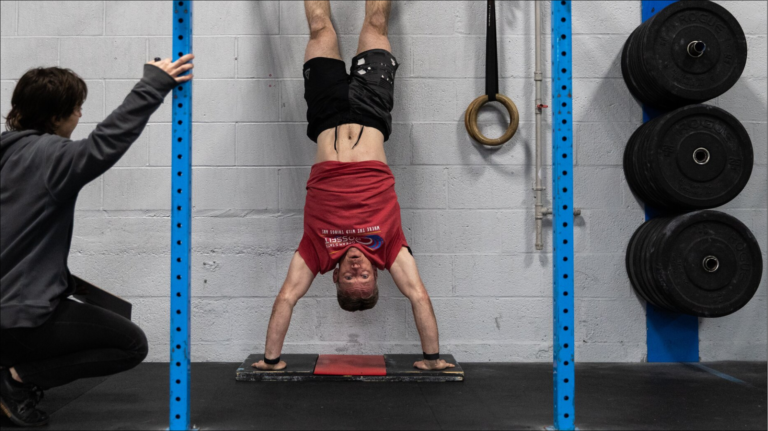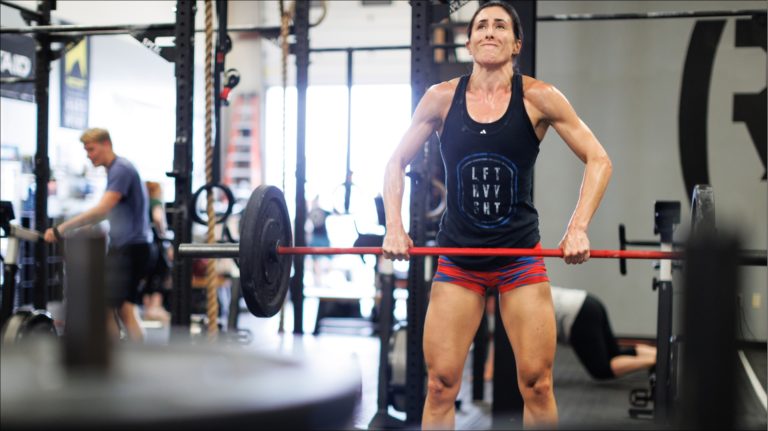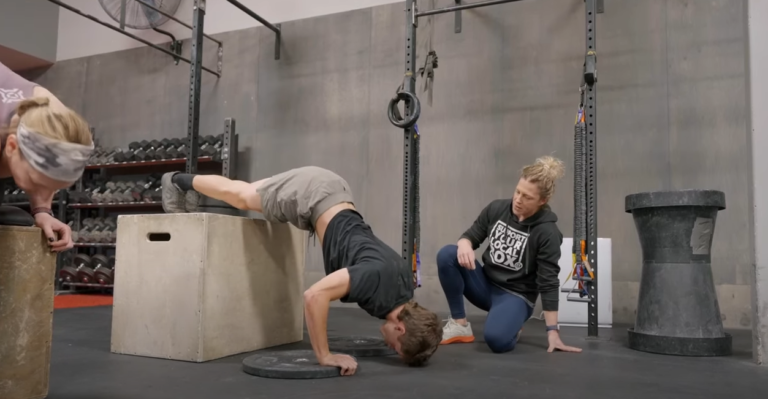Lara arrives at the affiliate at 9 a.m. after dropping her two young children off at the bus stop. She usually walks in with lip gloss, pink glittery nails, and long shiny hair perfectly in place. Lara decided to try CrossFit a few years ago, looking to set a good example for her family. She is a ninja at basic bodyweight movements and has great Olympic lifting form. She struggles with hanging movements, and cycling the barbell is something she is working hard to improve. She is mentally tough, relentless, and focuses on good mechanics.
Ilenia trains in the evenings; she comes to the affiliate with all the tattoos and accessories, and even brings grips for newbies at the gym. She often trains with her super-fit boyfriend. Ilenia is a firebreather, and she loves pushing herself to her limits. Her wheelhouse includes short workouts with complex skills. She is working on how to pace herself for longer workouts, maintaining proper mechanics for heavy barbell lifts, and improving her technique for kipping movements. She is upbeat, coachable, and loves to talk strategy.
If you look at the whiteboard at the end of the day, Lara and Ilenia’s scores are often nearly identical. They flip-flop who finishes first and lifts more, with the other close behind, even though they don’t generally train in the same class. Both women have been training for a few years and are similar in age, yet their approach to training and their personalities could not be further apart. While their fitness levels are similar, these two athletes need different tactics to scale workouts to optimize their health.
In the CrossFit Level 1 Certificate Course, participants learn the basics for scaling workouts to preserve the intended stimulus of the Workout of the Day. This strategy can involve modifying loads, volume, and movements in a challenging yet appropriate way for the athlete’s physical and psychological tolerance. During the Level 2 Certificate Course, we delve further into scaling for general groups of athletes, including beginners, intermediate, and advanced athletes, and those who need specific adaptations due to other circumstances such as pregnancy or physical limitation.

Beginners need exposure to the movements and to practice sound mechanics.
Intermediate athletes need to refine movement patterns and develop high-level skills while forging a path toward completing workouts as prescribed. Their abilities vary greatly; it’s important to identify their strengths, weaknesses, and what keeps them coming to the affiliate year after year.
Advanced athletes need to be consistently challenged for more intensity via increased speed or loading and, on rare occasions, potentially increased skill demands of the workout.
Lara and Ilenia fit into this “intermediate” category because their basic mechanics are solid, they have developed a tolerance for intensity, and they often require scaling to hit the workout stimulus. Sometimes they perform the workout as prescribed, and sometimes they only need to tweak a small portion to accommodate their current capabilities.
Even though they both fit into the same category, individualized scaling for intermediate athletes helps enable athletes to move closer to performing workouts as prescribed while acquiring new skills. Additionally, beyond the individualized scaling, they each also need a variety of scales to avoid repetition and inadvertently limit their progress. They will optimize the time and energy spent at the affiliate when their workouts are scaled to fit their needs best.
Here are two workouts from CrossFit Affiliate Programming (CAP) that both women recently completed that help illustrate how trainers can tailor workouts for intermediate individuals.
Workout 1
3 rounds for time of:
30 Russian kettlebell swings (35 lb)
15 handstand push-ups
*The intended stimulus is 5-9 minutes, with each movement completed in 1-2 sets.
Lara scaled to 10 pike push-ups of a box and finished in 5:49. She went home beaming because she did her first few strict handstand push-ups in the specific warm-up with a trainer spotting.
Ilenia scaled to 10 handstand push-ups. She was instructed to do two sets of 1-3 reps off the wall and complete the set of 10 by finishing with pike push-ups off a box. She finished the third round of kettlebell swings just after 7 minutes. Because her technique was solid, I told her she had until 10 minutes to finish the workout, allowing her to complete more than two sets on the wall if she wanted. She finished all 10 handstand push-ups on the wall in 9:42.

The next time handstand push-ups come up for these two athletes, I will have them tackle the total volume and/or make the pike version more challenging by having their hands raised on dumbbells or plates to create a small deficit. Lara was challenged beyond her comfort zone in the specific warm-up and then set up to smash the workout with a demanding but doable movement scale. Ilenia was held back, with limited reps in the first two rounds, to ensure movement quality, because she tends to break down in technique. She is learning that sometimes one step back will allow a couple of steps forward. As coaches, we always need to take note of what athletes have done and plan what we’ll have them do next time to keep them progressing. Stagnant scaling leads to stagnant results.
Workout 2
5 rounds for time of:
15-calorie row
12 deadlifts (105 lb)
9 hang power cleans (105 lb)
*The intended stimulus is 8-15 minutes, with the row taking no more than 1 minute, 20 seconds, and the barbell work completed in 1-2 sets per movement.
Lara used the listed intermediate rep scheme of 12-calorie row, 8 deadlifts, and 6 hang power cleans, and scaled the barbell movements to 65 lb. Barbell cycling does not come easily to her, so we set her up with a weight where she could practice while still being challenged. Her goal was to keep her feet in a shoulder-width stance throughout the hang power cleans to be more efficient despite the movement redundancy in this workout. The final rounds were tough to hang on to the barbell, but she pushed through, finishing the workout in 11:30.
Ilenia looked solid during the warm-up. We decided she would only adjust the load, knowing it would be tough for her to finish within the intended stimulus. She pushed herself with 75 lb on the bar to finish in 15:27.

The next time a workout like this comes up, Lara will again scale volume and work on putting some more weight on the barbell. It may be an additional 5-10 lb, but accumulating those small, steady increments got her this fit in the first place.
After looking at Ilenia’s score, it may seem like she needs a total volume reduction or to decrease the weight on the bar to have hit the stimulus, but there is only one minor adjustment I would make next time: the calories on the rower. She rowed hard and fast but took a longer transition to the bar. The weight and reps for the barbell movements were fine; she went unbroken with solid technique. Because she has not prioritized improving her rowing technique, and her size and current strength make rowing for calories challenging enough that the row plays an outsized role, tweaking the calories to 12 or 13 would give her the sub-15-minute finish we were looking for.
Scaling is neither linear nor one-dimensional. Sometimes we miss the mark, which is part of the learning process. While there are many factors to consider for any workout, think about the following things for your intermediate athletes: strengths, weaknesses, personality, reason for showing up, and who they admire at the affiliate. Use that information when deciding scaling options for them, and be open to various options to drive adaptations for your intermediate athletes.

If doing this for a larger group of athletes seems overwhelming, remember, these tailored approaches do not need to be grandiose. Start small, think about one intermediate athlete, give them a little challenge or additional thought before class begins. Over time, you will build confidence with scaling these athletes. Individualized scaling reflects positively on the culture of the affiliate, normalizing adjustments and making it easier for all types of athletes to understand that scaling is a valuable tool to help optimize for health.
Want more information on scaling? Take our online scaling course.
Have a question for a coach? Please submit that here.
